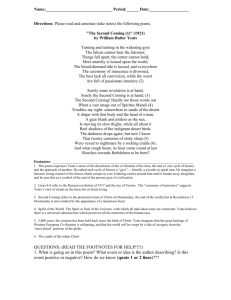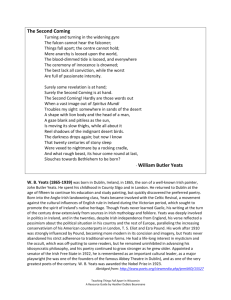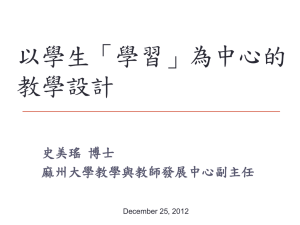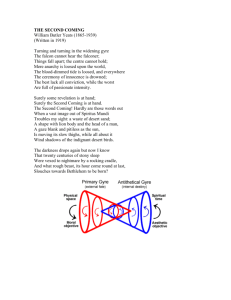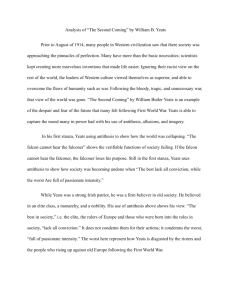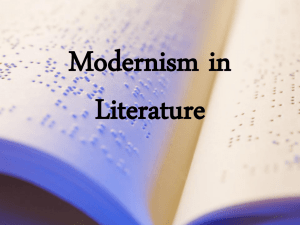A Literary Analysis of W.B. Yeats's “The Second Coming” In Light of
advertisement
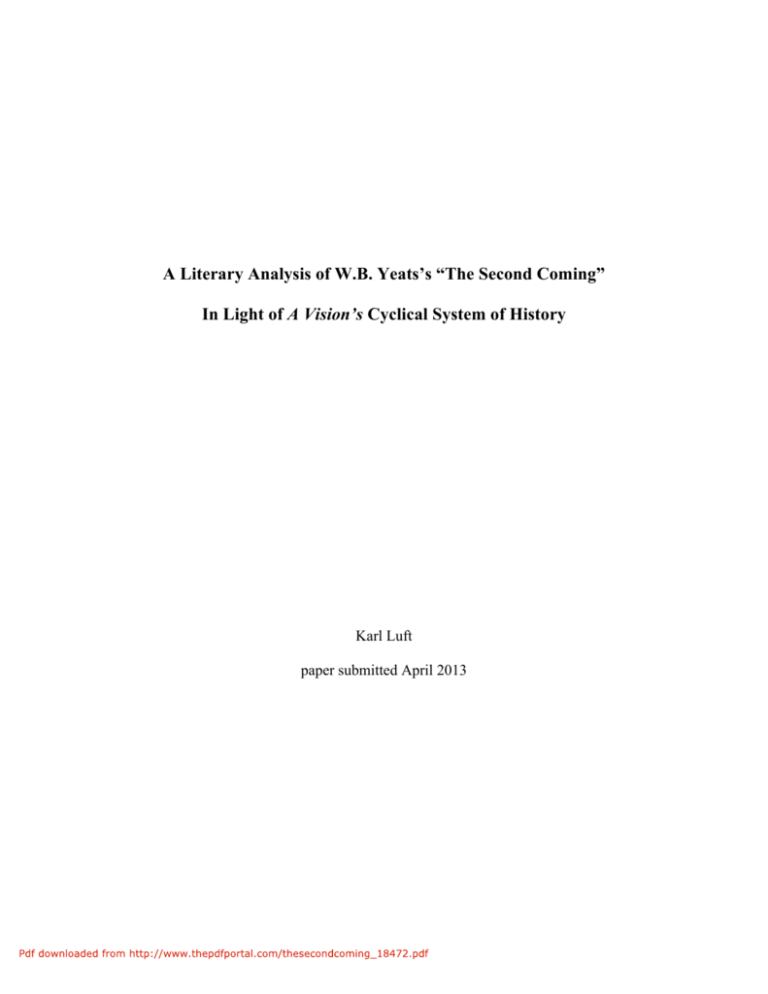
A Literary Analysis of W.B. Yeats’s “The Second Coming” In Light of A Vision’s Cyclical System of History Karl Luft paper submitted April 2013 Pdf downloaded from http://www.thepdfportal.com/thesecondcoming_18472.pdf Karl v.d. Luft, 1 Introduction “The Second Coming” was composed by William Butler Yeats in 1919, the year after the end of World War I. Although it has been an important historical contribution to Modernist poetry, there is significant disagreement regarding the poem’s actual meaning and intent. This is primarily because much of the poem’s imagery is founded in a complex historical system that Yeats constructed in his book A Vision, which is itself complicated and esoteric in the extreme. This system deserves significant attention in any attempted analysis of “The Second Coming”, but it would be a mistake to ignore the poet’s surrounding cultural atmosphere. Some give a great deal of attention to this atmosphere, citing the parallels between the first stanza’s chaotic language and the social disruption of war, as seen in the Irish rebellion, the French, German, and Russian revolutions, and World War I. The combination of these considerations properly realizes the poem’s and the author’s dual historical and literary contexts, and recognizes that the Yeats’s cyclical system goes hand-in-hand with his entire view of the world. “The Second Coming” has a scattered rhythmic meter at best, and its rhyme scheme is almost non-existent. Nevertheless, Yeats’s words have such intensity that they have the capacity to produce powerful, dark images of societal antithesis in our minds. This linguistic forcefulness combines with Yeats’s complex imagery to create a poem that is both eerily prophetic of the subsequent World conflicts, and also an intriguing insight into the poet’s systematic view of history, society, ideology, and dominance. The Second Coming Turning and turning in the widening gyre The falcon cannot hear the falconer; Things fall apart; the centre cannot hold; Pdf downloaded from http://www.thepdfportal.com/thesecondcoming_18472.pdf Karl v.d. Luft, 2 Mere anarchy is loosed upon the world, The blood-dimmed tide is loosed, and everywhere The ceremony of innocence is drowned; The best lack all conviction, while the worst Are full of passionate intensity. Surely some revelation is at hand; Surely the Second Coming is at hand. The Second Coming! Hardly are those words out When a vast image out of Spiritus Mundi Troubles my sight: somewhere in sands of the desert A shape with lion body and the head of a man, A gaze blank and pitiless as the sun, Is moving its slow thighs, while all about it Reel shadows of the indignant desert birds. The darkness drops again; but now I know That twenty centuries of stony sleep Were vexed to nightmare by a rocking cradle, And what rough beast, its hour come round at last, Slouches towards Bethlehem to be born. The Cyclical System The opening image of “The Second Coming” derives from a complex system that Yeats formulated in A Vision: An Explanation of Life Founded Upon the Writings of Giraldus and upon Certain Doctrines Attributed to Kusta Ben Luka, a book first published in 1925. Much of this system is not particularly relevant to an analysis of “The Second Coming”. Furthermore, the ideas of A Vision are often extremely difficult to interpret because the author either presents or receives his thoughts in mystical fictions and séances, and his prose does not stylistically lend itself to definitive coherency (Mann, Foundations, 1). On the other hand, there is such an indisputable parallel between this poem and his cyclical pattern of history that it almost certainly cannot be fully understood without at least a cursory summary and examination of that pattern (Iliopoulos, 176). Pdf downloaded from http://www.thepdfportal.com/thesecondcoming_18472.pdf Karl v.d. Luft, 3 The poet’s esoteric system, simply put, imagines two complementary vortexes, as pictured in the image above1. In A Vision, Yeats terms these coinciding spirals ‘the expanding and contrasting gyres’ (Yeats, 129)2. For Yeats, these cones represent or embody a sort of dualistic pattern that history follows continuously throughout time and space. This continuity is shown in the image to the right. In his 1921 compendium of poetry, Michael Robartes and the Dancer, Yeats summarizes his understanding of the dual gyres’ importance in a note to “The Second Coming”, saying: “The mind , whether expressed in history or in the individual life, has a precise movement, which can be quickened or slackened but cannot be fundamentally altered, and this movement can be expressed by a mathematical form.” In this pattern, the two gyres wax and wane reciprocally to each other. For Yeats, these gyres signify two opposing forces or essences in the space-time continuum (Mann, Foundations, 5). When one force reaches its climax, the other reaches its nadir, and vice versa, as we can see in these two images. In Yeats’s system, the dominance of one force is dramatically transferred to its almost-dormant antithesis directly after it reaches its widest point. Together, these eternally cycling vortexes contain the sweep of history, and this transference of dominance symbolizes a violent change in society’s course and general ideology. As has already been stated or hinted at, Yeats’s spiritual mysticism, and ideas about mediumship, séances and social prophecy are large influences on his entire conic system. This Pdf downloaded from http://www.thepdfportal.com/thesecondcoming_18472.pdf Karl v.d. Luft, 4 system itself only forms a small part of the poet’s written thought and experience in A Vision. The bounds of both of these things far exceed the confines of this paper, but apprehending the basic symbolism of what Yeats terms the primary and antithetical gyres is tantamount to understanding one of the fundamental metaphoric foundations of this poem. Lines 1-8 (First Stanza) In this first stanza, the speaker presents his audience with a disturbing picture of a chaotic world. The motion of the falcon in the first two lines corresponds directly to the primary gyre of Yeats’s historical system. Circling higher and higher in this widening vortex, the bird can no longer hear his owner’s call. The falconer represents the dominance of a particular controlling force in society, and he is standing at the source of the ascending gyre. But his control has been lost, and the falcon is beyond the reach of his voice. This imagery runs parallel with the imagery of the primary gyre. As the bird circles out of control, so this gyre reaches its widest point, signifying the imminence of a cataclysmic change and a new dominance per Yeats’s system. The poet continues with the same violent, arresting tone: ‘Things fall apart; the centre cannot hold; mere anarchy is loosed upon the world.’ After a time, as has been noted, movement farther away from the source of the primary spiral means that the antithetical spiral is about to become primary. ‘The centre cannot hold,’ then, corresponds to the falconer’s loss of control and the end of the widening gyre’s primacy. Given Yeats’s language, it is fairly clear that this social change is not accomplished smoothly, but rather is accompanied (or preceded) by an outpouring of chaos and general anarchy on the world as a whole. Pdf downloaded from http://www.thepdfportal.com/thesecondcoming_18472.pdf Karl v.d. Luft, 5 ‘The blood-dimmed tide is loosed, and everywhere / the ceremony of innocence is drowned.’ Yeats complements his previous statements with a dark picture of a plague-like event, reminiscent of the biblical worldwide flood. But this flood is not loosed as a judgment on the ostensibly guilty; instead, its waters are tainted with the blood of innocents. In keeping with the Christian and anti-Christian imagery of the second stanza, as we will see later, the baptismal waters of ‘the ceremony of innocence’ are drowned by another, all-encompassing water. This water is tainted with the blood of its victims. In a sense, then, this calamity does not simply destroy the innocent themselves, but also their method of becoming innocent in the Christian system. This entire section summons up a mental picture in the reader’s mind of a world, once innocent and orderly, but now completely revolutionized with a tide of anarchical confusion. Rhetorically, this is leading up to the opening proclamations of the second stanza. The falcon, once wild and free, then tamed and controlled, has returned to its original state, and is now beyond the reach of the falconer’s command. The ceremony of innocence is stained with blood, good men have become apathetic, and the fervor of evil men has increased to the highest degree. Although these images are a powerful presentation of Yeats’s historical thought, they are also meant to be indicative of the real historical events of Yeats’ own day. This time was overshadowed by constant destructive conflicts, especially the ‘bloody tide’ of World War I, and a number of other national revolutions that were far closer to the poet’s heart. Lines 9-22 (Second Stanza) Pdf downloaded from http://www.thepdfportal.com/thesecondcoming_18472.pdf Karl v.d. Luft, 6 Yeats has led up to the last stanza with dire descriptions of disorderly confusion, and he answers these descriptions with a proclamation in the ninth and tenth lines. ‘Surely some revelation is at hand;’ says the speaker, ‘surely the Second Coming is at hand.’ Although at first glance ‘the Second Coming’ seems to be (and almost certainly is) a biblical/messianic reference, there is a bit more at play here. This ‘second coming’ or ‘revelation’ directly refers to the cataclysmic change that is integral to Yeats’s cyclical system. For the poet, the current primary gyre began with Christ’s birth, and is currently in its closing climax. This explains why the Christian mores are disintegrating throughout the entire first section, and why a sea of blood drowns the Christian rite. If the reader were aware of the author’s system, he would already know that Yeats is turning our common conception about the ‘Second Coming’ on its head. At this point in the poem, however, the speaker confirms this when he shifts from general description to personal vision or experience—‘The Second Coming! Hardly are those words out / when a vast image out of Spiritus Mundi troubles my sight…’ The Spiritus Mundi is literally the ‘spirit of mankind.’ Mid-poem, the speaker encounters an image that ostensibly comes from the common psychic mind of humanity, the thought (whether intellectual, spiritual, or both) of all sentient beings. The picture that the speaker sees is extremely vague. It is probably a description of a massive sphinx, however, ‘a shape with lion body and the head of a man.’ This vagueness is certainly intentional, both to be consistent with the rhetorical use of a vision in the poem, and to increase the portentousness of the ‘vast image.’ In the context of both “The Second Coming” and Yeats’ system, this creature is a second Messiah. But his ‘Second Coming’ is far more foreboding than the biblical coming that his readers would tend to expect. ‘Somewhere in sands Pdf downloaded from http://www.thepdfportal.com/thesecondcoming_18472.pdf Karl v.d. Luft, 7 of the desert’ it ‘is moving its slow thighs’ ominously, ‘while all around it / reel shadows of the indignant desert birds.’ This does not describe a sudden biblical coming, but rather the progressive transference of the conic system. For Yeats, this “Messiah” is not coming as a thief in the night. His ‘return’ is anticipated by reeling shadows, which are again analogous to the angry chaos of the widening gyre. ‘The darkness drops again.’ The poet’s startling vision has ceased, but now he has a fuller knowledge after his experience. He still sees the disorder wreaked by ‘the blood-dimmed tide,’ but now he realizes what has caused it. ‘The darkness drops again,’ line 18 reads, ‘but now I know / that twenty centuries of stony sleep / were vexed to nightmare by a rocking cradle, / and what rough beast, its hour come round at hast, / slouches towards Bethlehem to be born.’ These lines indicate a preparation and a slow vexation, comporting with the cyclical system of vortexes. The forbidding sphinx has slept like a stone for a 2000-year cycle, from the birth of Christ to the present. But now the cycle is almost complete, as the primary gyre widens and the antithetical gyre comes to a point. Now the poet cements the overturned images in the mind of his reader. This “Messiah” is not a returning Christ at all; rather, he is a sort of apocalyptic antichrist, the ‘rough beast’ out of Revelation. Yeats’ ascending gyre began to widen with the birth of Christ, which signified the beginning of a particular social force. Now, reaching its climax after ‘twenty centuries of stony sleep,’ it brings with it a monstrous social transformation, signified by the monster itself that ‘slouches towards Bethlehem to be born.’ And this monster, already psychically seen in the Spiritus Mundi, will soon show itself in a far more real way. For Yeats’s, the image is a dark portent representing the cataclysmic cultural change that he expects, per the mystical system of A Vision. Pdf downloaded from http://www.thepdfportal.com/thesecondcoming_18472.pdf Karl v.d. Luft, 8 Conclusion The presence of separate interpretations has come to somewhat define “The Second Coming” in certain critics’ minds, and perhaps rightly so. Any attempted analysis would probably benefit from a holistic view of these examinations. It is certain, in any scenario, that the poem’s meaning is multi-faceted, influenced by a number of historical, contextual, biographical, and quasi-religious factors. Even if it is separated from Yeats’s historical thesis, the poem still contains powerfully passionate internal language and symbolism, paralleling and overturning long-understood biblical, spiritual, and cultural images. But for someone reading the poem apropos of the wider literary context of Yeats’s poetry and prose, it is a powerful reiteration of the poet’s cyclical historical system. As such, it is an important part of any study involving the antithetical ideas and ideals that defined the course of history’s ebb and flow in Yeats’s mind. Bibliography: Titles Yeats, William Butler. A Vision: An Explanation of Life Founded Upon the Writings of Giraldus and Upon Certain Doctrins Attributed to Kusta Ben Luka. Yeats, William Butler. Michael Robartes and the Dancer. Mann, Neil. “Everywhere that antinomy of the One and the Many”: The Foundations of A Vision. Watkins, Alison. The Imaginative Construction of the Soul in W.B. Yeats’s A Vision. Gibson, Matthew. Magical Romanticism: Yeats’s Absorption of Romantic Writers into Fin-DeSiecle Movements. Iliopoulos, Spyridon. ‘Out of a Medium’s Mouth’: Yeats’s Art in Relation to Mediumship, Spiritualism, and Psychical Research. DeForrest, Matthew. Philosophical Differences and Yeats’s Corroborative System in Yeats’s A Vision. DeForrest, Matthew. W.B. Yeats’s A Vision: “Dove or Swan”. Pdf downloaded from http://www.thepdfportal.com/thesecondcoming_18472.pdf Karl v.d. Luft, 9 1 Credit for all images, unless otherwise noted, goes to Neil Mann, coeditor of and contributor to W.B. Yeats “A Vision”: Explications and Contexts (Clemson University Digital Press). 2 Yeats’s original drawing of these gyres in A Vision is seen here: Pdf downloaded from http://www.thepdfportal.com/thesecondcoming_18472.pdf
